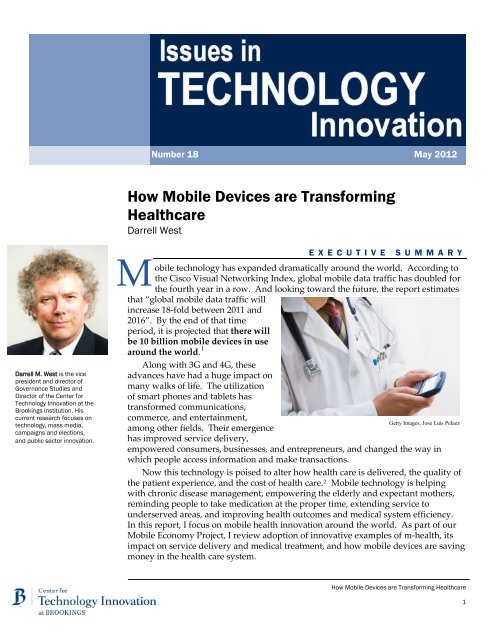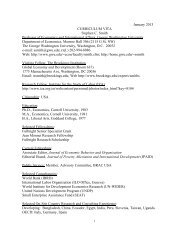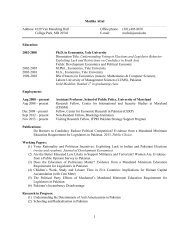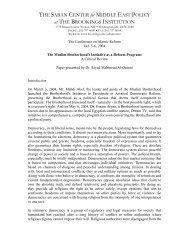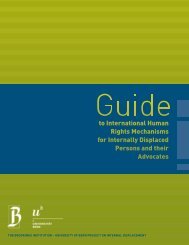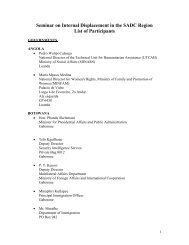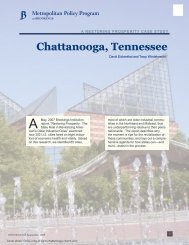How Mobile Devices are Transforming Healthcare - Brookings ...
How Mobile Devices are Transforming Healthcare - Brookings ...
How Mobile Devices are Transforming Healthcare - Brookings ...
Create successful ePaper yourself
Turn your PDF publications into a flip-book with our unique Google optimized e-Paper software.
Darrell M. West is the vice<br />
president and director of<br />
Governance Studies and<br />
Director of the Center for<br />
Technology Innovation at the<br />
<strong>Brookings</strong> Institution. His<br />
current research focuses on<br />
technology, mass media,<br />
campaigns and elections,<br />
and public sector innovation.<br />
Number 18 May 2012<br />
<strong>How</strong> <strong>Mobile</strong> <strong>Devices</strong> <strong>are</strong> <strong>Transforming</strong><br />
Healthc<strong>are</strong><br />
Darrell West<br />
EXECUTIVE SUMMARY<br />
obile technology has expanded dramatically around the world. According to<br />
the Cisco Visual Networking Index, global mobile data traffic has doubled for<br />
the fourth year in a row. And looking toward the future, the report estimates<br />
that “global mobile data traffic will<br />
increase 18-fold between 2011 and<br />
2016”. By the end of that time<br />
period, it is projected that there will<br />
be 10 billion mobile devices in use<br />
around the world. 1<br />
Along with 3G and 4G, these<br />
advances have had a huge impact on<br />
many walks of life. The utilization<br />
of smart phones and tablets has<br />
transformed communications,<br />
commerce, and entertainment,<br />
among other fields. Their emergence<br />
has improved service delivery,<br />
empowered consumers, businesses, and entrepreneurs, and changed the way in<br />
which people access information and make transactions.<br />
Now this technology is poised to alter how health c<strong>are</strong> is delivered, the quality of<br />
the patient experience, and the cost of health c<strong>are</strong>. 2 M<br />
Getty Images, Jose Luis Pelaez<br />
<strong>Mobile</strong> technology is helping<br />
with chronic disease management, empowering the elderly and expectant mothers,<br />
reminding people to take medication at the proper time, extending service to<br />
underserved <strong>are</strong>as, and improving health outcomes and medical system efficiency.<br />
In this report, I focus on mobile health innovation around the world. As part of our<br />
<strong>Mobile</strong> Economy Project, I review adoption of innovative examples of m-health, its<br />
impact on service delivery and medical treatment, and how mobile devices <strong>are</strong> saving<br />
money in the health c<strong>are</strong> system.<br />
<strong>How</strong> <strong>Mobile</strong> <strong>Devices</strong> <strong>are</strong> <strong>Transforming</strong> Healthc<strong>are</strong><br />
1
Issues in Technology Innovation<br />
The Center for Technology<br />
Innovation at <strong>Brookings</strong> has<br />
launched its inaugural<br />
paper series to seek and<br />
analyze public policy<br />
developments in technology<br />
innovation.<br />
The Center for Technology<br />
Innovation<br />
Founded in 2010, the<br />
Center for Technology<br />
Innovation at <strong>Brookings</strong> is<br />
at the forefront of shaping<br />
public debate on technology<br />
innovation and developing<br />
data-driven scholarship to<br />
enhance understanding of<br />
technology’s legal,<br />
economic, social, and<br />
governance ramifications.<br />
<strong>Mobile</strong> Economy Project<br />
The <strong>Mobile</strong> Economy Project<br />
examines how the rapid<br />
expansion of mobile technology<br />
around the world is transforming<br />
economic opportunity for<br />
millions.<br />
The Rise of mHealth Initiatives<br />
There has been an explosion of mHealth activities around the world. A 2011 global<br />
survey of 114 nations undertaken by the World Health Organization found that<br />
mHealth initiatives have been established in many countries, but there is variation in<br />
adoption levels. 3 The most common activity was the creation of health call centers,<br />
which respond to patient inquiries. This was followed by using SMS for appointment<br />
reminders, using telemedicine, accessing patient records, measuring treatment<br />
compliance, raising health aw<strong>are</strong>ness, monitoring patients, and physician decision<br />
support.<br />
40<br />
35<br />
30<br />
25<br />
20<br />
15<br />
10<br />
5<br />
0<br />
Adoption of mHealth Initiatives<br />
Around the Globe<br />
Not surprisingly, there were big differentials between developed and developing<br />
nations. Africa had the lowest rate of mHealth adoption while North America, South<br />
America, and Southeast Asia showed the highest adoption levels. A number of<br />
countries have initiatives in the pilot stage or have informal activities that <strong>are</strong><br />
underway.<br />
Member states reported their biggest mHealth obstacles were competing<br />
priorities, budgetary restrictions, and staff shortages. Concerns over privacy and data<br />
security also were cited as barriers to effective implementation. Most countries <strong>are</strong><br />
implementing mHealth through various types of public-private partnerships.<br />
Managing Chronic Diseases Through Remote Monitoring and<br />
<strong>Mobile</strong> <strong>Devices</strong><br />
Chronic disease management represents the greatest health c<strong>are</strong> challenge in many<br />
locales. Remote monitoring devices enable patients with serious problems to record<br />
their own health measures and send them electronically to physicians or specialists.<br />
<strong>How</strong> <strong>Mobile</strong> <strong>Devices</strong> <strong>are</strong> <strong>Transforming</strong> Healthc<strong>are</strong><br />
2
Remote monitoring<br />
technologies could<br />
save as much as<br />
$197 billion over<br />
the next 25 years.<br />
This keeps them out of doctor’s offices for routine c<strong>are</strong>, and thereby helps to reduce<br />
health c<strong>are</strong> costs.<br />
A <strong>Brookings</strong> Institution analysis undertaken by economist Robert Litan found<br />
that remote monitoring technologies could save as much as $197 billion over the<br />
next 25 years in the United States. 4 He found that cost savings were especially<br />
prevalent in the chronic disease <strong>are</strong>as of congestive heart failure, pulmonary disease,<br />
diabetes, and skin ulcers. With around the clock monitoring and electronic data<br />
transition to c<strong>are</strong>-givers, remote devices speed up the treatment of patients requiring<br />
medical intervention. Rather than having to wait for a patient to discover there is a<br />
problem, monitors identify deteriorating conditions in real time, and alert physicians.<br />
Real-time management is especially important in the case of chronic diseases. In<br />
the <strong>are</strong>a of diabetes, for example, it is crucial that patients monitor their blood glucose<br />
levels and gear their insulin intake to proper levels. In the “old days” based on faceto-face<br />
encounters, patients had to visit a doctor’s lab or medical office, take a test,<br />
and wait for results to be delivered. That process was expensive, time-consuming,<br />
and inconvenient for all-involved. Having to get regular tests for this and other<br />
conditions is one of the factors that drive up medical costs.<br />
<strong>How</strong>ever, it is possible to use remote monitoring devices at home that record<br />
glucose levels instantaneously and electronically send them to the appropriate health<br />
c<strong>are</strong> provider. Patients <strong>are</strong> using “Gluco Phones” that monitor and transmit glucose<br />
information to c<strong>are</strong>givers while also reminding patients when they need to undertake<br />
glucose tests. This puts people in charge of their own test-taking and monitoring and<br />
keeps them out of doctor’s offices until they need more detailed c<strong>are</strong>. It is estimated<br />
that over 11 million Americans use home monitors for their glucose. Health<br />
authorities believe there <strong>are</strong> over 24 million diabetics in the United States, and the<br />
disease is the seventh leading cause of death.<br />
Researchers at the University of Massachusetts Medical School have developed<br />
remote monitoring devices called iHeal for substance abusers. Individuals wear<br />
sensors that monitor skin temperature and nervous system activities associated with<br />
drug cravings. When combined with self-reported stress levels, the devices transmit<br />
data to health providers trained to look for risky behavioral and physiological<br />
patterns and provide various types of text, video, and audio interventions designed<br />
to discourage drug use. Physicians report positive reactions from participants in<br />
residential treatment programs deploying the system. 5<br />
A study of a smoking cessation program relying upon mobile devices found some<br />
positive benefits. Researchers identified 47 different applications designed to stop<br />
smoking. These apps counted the number of cig<strong>are</strong>ttes smoked, suggested<br />
visualizations designed to encourage people to quit smoking, or employed quota<br />
systems or calculators that sought to reduce smoking levels. The project found “some<br />
promise” in text messaging interventions in smoking, but also documented that many<br />
apps needed to connect to outside resources, such as health clinics or counseling<br />
services. The authors suggested that app developers adhere more closely to public<br />
health guidelines on smoking cessation. 6<br />
<strong>How</strong> <strong>Mobile</strong> <strong>Devices</strong> <strong>are</strong> <strong>Transforming</strong> Healthc<strong>are</strong><br />
3
In Mexico, diabetes is the biggest chronic health c<strong>are</strong> problem. Public health data<br />
indicate that the disease has “increased 25% over the last seven years and that 14% of<br />
the population with diabetes is younger than 40 years old.” 7 In addition, it is<br />
estimated that over 15 percent of adults living near the U.S./Mexico border <strong>are</strong><br />
diabetic.<br />
A clinical study begun in November 2011 proposes to examine how 3G wireless<br />
internet access can be used in diabetes management to improve patient c<strong>are</strong> for<br />
marginalized communities. Health c<strong>are</strong> workers in Tijuana employ a mobile<br />
application to interact with patients. Participants can use the application to access<br />
videos and health education on diabetes self-management and send interactive<br />
questionnaires to health c<strong>are</strong> workers. Patient’s responses <strong>are</strong> sent through their 3G<br />
mobile phones, making them instantly available in a database for the health c<strong>are</strong><br />
providers to review and follow up. Alerts <strong>are</strong> sent when patients report significantly<br />
out of range indicator levels or when the system identifies lack of adherence to<br />
appointments tests or classes.<br />
Another example of remote monitoring in regard to chronic diseases is found in<br />
China. Qualcomm’s Wireless Reach in partnership with Life C<strong>are</strong> Networks and<br />
the Community Health Association of China, has deployed an electrocardiogram<br />
sensing handset that records 30 seconds of heart data and transmits that information<br />
electronically to the 24-hour Life C<strong>are</strong> Networks Call Center in Beijing. That facility<br />
has over 40 physicians and the wireless monitors enable remote diagnosis to patients<br />
in underserved <strong>are</strong>as and provide real-time feedback to those with cardiovascular<br />
diseases. Cardiovascular diseases kill 3 million individuals annually in China, and<br />
those outside the major cities have difficulty getting access to medical c<strong>are</strong>. 8 The<br />
impact this program has had on improving health c<strong>are</strong> earned it a Computerworld<br />
Honors Laureate award for 2012.<br />
HIV/AIDS is the big public health challenge in Kenya, with 6.3 percent of the<br />
adult population diagnosed with HIV. The delivery of Antiretroviral Treatment<br />
(ART) is a key component of the government’s strategy to reduce HIV/AIDS-related<br />
morbidity and mortality, which can be compromised due to ineffective records<br />
management. But through 3G wireless technology, reductions in the administrative<br />
burden on health c<strong>are</strong> workers and improvements in patient c<strong>are</strong> could be achieved<br />
by strengthening pharmaceutical management systems for ART. According to<br />
evaluation analysis, “the percentage of facilities completing reports at the time of<br />
dispensing increased 70%.” In addition, “the average time spent on delivery of<br />
reports to KEMSA (the Kenyan Medical Supplies Agency) was reduced from eight<br />
hours to five minutes.” 9<br />
Pilot projects in India and Sri Lanka have found mobile devices very helpful in<br />
monitoring outbreaks of Dengue Fever. In the world before mobile communications,<br />
it generally took the provinces 15 to 30 days to report data on disease outbreaks to<br />
central authorities. The time lost here slowed treatment responses and aggravated<br />
the spread of infectious diseases. <strong>How</strong>ever, with the onset of mobile and digital<br />
<strong>How</strong> <strong>Mobile</strong> <strong>Devices</strong> <strong>are</strong> <strong>Transforming</strong> Healthc<strong>are</strong><br />
4
Sixteen percent<br />
said the mobile<br />
equipment had<br />
helped them avoid<br />
at least one error in<br />
clinical treatment.<br />
communications, the wait time on infectious diseases has dropped considerably. 10<br />
Through the Real-Time Biosurveillance Program relying on mobile devices, public<br />
health authorities use data mining techniques to look for “anomaly detection” in<br />
disease patterns. Areas reporting major outbreaks receive additional resources for<br />
diagnosis and treatment, and this helps to limit the spread of the disease.<br />
A review of 13 evaluation studies of mobile devices and physician practices in the<br />
<strong>are</strong>a of reading electrocardiographs or computerized tomography scans found three<br />
benefits: 1) physicians with access to mobile devices responded more promptly to<br />
reading medical test results, 2) there were fewer errors in medication prescription and<br />
hospital discharging, and 3) doctors showed improved data management and recordkeeping<br />
practices. 11<br />
Indeed, error avoidance is one of the primary strengths of mHealth. A study of<br />
nurses relying upon handheld devices found that 16 percent said the mobile<br />
equipment had helped them avoid at least one error in clinical treatment while<br />
another six percent indicated it had enabled them to avoid errors on multiple<br />
occasions. 12 These positive findings demonstrate that mHealth has the ability to<br />
improve service delivery and save money in health c<strong>are</strong>.<br />
Helping the Elderly and Expectant Mothers<br />
One of the biggest problems for elderly patients is forgetting to take their prescription<br />
drugs. It is estimated that only 50 percent of patients take their medication as<br />
prescribed. 13 Either they forget to take the drug or they do not take it at the time or<br />
dosage set by their physician. This means that we lose half of the benefit of<br />
prescription drugs through human error. This costs the systems billions in negative<br />
health outcomes.<br />
<strong>Mobile</strong> technology has the potential to help with this and communications<br />
problems. Patients no longer need to visit doctors’ offices to be reminded to take<br />
their medicine. They can get personal reminders via e-mail, automated phone calls,<br />
or text messages. Text4Baby is a mobile application for pregnant women. It sends<br />
text messages in English and Spanish on how to handle various stages of pregnancy<br />
and problems that come up. This site has signed up 281,000 new mothers in the<br />
United States. 14<br />
In South Africa, a physician worried that his patients did not always take the<br />
prescribed Rifafol medicine for their tuberculosis. He knew that for the drug to be<br />
effective, people had to take the pill on a consistent basis. Otherwise, it would have<br />
little effect. So the doctor set up a text messaging service called “On-Cue<br />
Compliance” for each of his patients that sent them a daily SMS in English, Afrikaans,<br />
or Xhosa. Over the six-month course of treatment, his service would send a message<br />
at a pre-determined time each day reminding them to take Rifafol.<br />
In the United States, Dynamed Solutions provides “HealtheTrax” softw<strong>are</strong> that<br />
reminds patients to take medications, set up appointments, and track compliance<br />
with medical instructions. This and other types of “virtual health assistants” <strong>are</strong><br />
<strong>How</strong> <strong>Mobile</strong> <strong>Devices</strong> <strong>are</strong> <strong>Transforming</strong> Healthc<strong>are</strong><br />
5
There <strong>are</strong> over<br />
40,000 mobile<br />
health applications<br />
across multiple<br />
platforms.<br />
particularly helpful with those suffering from chronic illnesses. These individuals<br />
need to keep close track of their medical condition and stay in touch with their<br />
c<strong>are</strong>givers. The softw<strong>are</strong> is integrated with electronic medical records and can store<br />
information in patient’s personal records.<br />
In Bangladesh, maternal mortality is the biggest killer. And neonatal deaths<br />
comprise more than half (57 percent) of fatalities under the age of five. To improve<br />
patient aw<strong>are</strong>ness, its doctors launched a <strong>Mobile</strong>s4Health initiative that provides how<br />
to take c<strong>are</strong> of expectant mothers during pregnancies, early warning signs of possible<br />
infant problems, the benefits of family planning, and breast feeding best practices. 15<br />
Dr. Robert Schwarzberg of Sensei Corporation has developed a mobile “coaching<br />
app” for chronic disease sufferers. Using a subscription model, it offers “weight loss<br />
advice [and] virtual coaching on issues, including diabetes and blood pressurecontrol”.<br />
16 It tracks physical activity and body mass numbers. Based on the person’s<br />
goals, it suggests food choices based on desired caloric intake and lessons on lifestyle<br />
and weight loss.<br />
Portsmouth Regional Hospital has a service designed to shorten patient waiting<br />
time for the emergency room. Patients can text “ER” to a designated number and get<br />
the anticipated wait time to see a doctor or nurse. This reduces waiting time and<br />
provides people with the time estimates they need. 17<br />
A review of 25 studies on voice and text messaging interventions in c<strong>are</strong><br />
management found significant benefits. In examining research on medical reminders<br />
sent to 38,060 individuals, researchers documented improvements “in compliance<br />
with medicine taking, asthma symptoms, stress levels, smoking quit races, and self<br />
efficacy. Process improvements were reported in lower failed appointments, quicker<br />
diagnosis and treatment, and improving teaching and training.” 18<br />
There were links to health outcomes through a combination of remote sensors and<br />
physical activity reminders. A study of a physical activity program in the United<br />
Kingdom found that real-time mobile feedback combined with wrist-worn<br />
accelerometers monitoring physical activity yielded positive results. Those getting<br />
virtual interventions showed an increase of 2 hours and 18 minutes per week in<br />
physical activity and lost 2.18 percent more body fat than a control group. 19<br />
The popularity of Apple’s iPad tablet has spawned a number of popular medical<br />
applications for mobile devices. Among its most widely-used apps <strong>are</strong> ones by<br />
Airstrip Cardiology that enable physicians to view electrocardiograms, an app by<br />
3D4Medical.com called Skeletal System which shows the human bone system, Orca<br />
Health’s EyeDecide MD which has optometrical information, and MIM Softw<strong>are</strong>’s<br />
<strong>Mobile</strong> MIM, which shows various types of medical imaging. 20<br />
Overall, the Apple iTunes store has over 12,000 apps related to health c<strong>are</strong>. 21 And<br />
it is estimated that there <strong>are</strong> over 40,000 mobile health applications across multiple<br />
platforms and that 247 million people have downloaded a health app. 22 While the<br />
impact of this growing market is still to be determined, it signals significant consumer<br />
interest in mHealth.<br />
<strong>How</strong> <strong>Mobile</strong> <strong>Devices</strong> <strong>are</strong> <strong>Transforming</strong> Healthc<strong>are</strong><br />
6
Extending Rural Access<br />
Access to medical c<strong>are</strong> in rural <strong>are</strong>as is a challenge in every country around the<br />
world. Nearly every nation has disparities between urban and rural <strong>are</strong>as. Health<br />
c<strong>are</strong> providers and specialists <strong>are</strong> more likely to be located in densely-populated<br />
jurisdictions because that is where hospitals and advanced equipment <strong>are</strong> found.<br />
Japan has a number of remote <strong>are</strong>as that <strong>are</strong> distant from urban centers. Some of<br />
them <strong>are</strong> located on sparsely-populated islands or in mountainous <strong>are</strong>as far from<br />
major cities. To improve access to medical c<strong>are</strong>, Medical Platform Asia gave the 300<br />
residents of rural Hokkaido 3G wireless devices that record and transmit blood<br />
pressure, weight, and distance walked through pedometers. Doctors examine the<br />
incoming data and make medical recommendations to each individual. Already,<br />
there have been substantial improvements in patient aw<strong>are</strong>ness on issues such as<br />
blood pressure management (aw<strong>are</strong>ness went from 50 to 100 percent during the pilot<br />
project) and the importance of being pro-active about medical c<strong>are</strong> (engagement rose<br />
from 70 to 100 percent). 23<br />
In China, rural doctors have been given mobile devices which can access<br />
electronic health records and health treatment data bases. This allows physicians to<br />
see patient health information and learn how to treat common problems. If<br />
necessary, clinicians <strong>are</strong> also able to remotely consult with specialists in urban<br />
systems. In Hebei Province, 150 rural doctors <strong>are</strong> using the system, which has helped<br />
them serve approximately 300,000 patients. 24<br />
In India, rural-dwellers gain access to medical c<strong>are</strong> far from their home towns<br />
through video conferencing. Using broadband connections, doctors geographically<br />
remote from patients can examine them and diagnose particular problems. In<br />
countries where physicians <strong>are</strong> in short supply in rural <strong>are</strong>as, this enables those in<br />
under-served locales to get medical treatment. 25<br />
Singapore has a mobile health application called Health Buddy that provides a list<br />
of medical symptoms and possible treatments, along with tips and videos on ways to<br />
promote good health. Patients can ask specialists detailed questions about particular<br />
illnesses and who they should see for medical c<strong>are</strong>. The app provides access to<br />
SingHealth, the government health portal with over 40 different medical specialties<br />
that <strong>are</strong> available. 26<br />
In Malawi, Josh Nesbit of Medic <strong>Mobile</strong> developed softw<strong>are</strong> that allowed health<br />
workers to text in medical information for rural patients. Rather than spend hours<br />
commuting to clinics, they could get quick diagnosis on routine symptoms and<br />
suggested treatments. According to him, “within six months of the system going live,<br />
the number of patients being treated for tuberculosis doubled, more than 1200 hours<br />
in travel time were eliminated, and emergency services became available in the <strong>are</strong>a<br />
for the first time.” 27<br />
In Bangladesh, 90 percent of childbirths in rural <strong>are</strong>as occur outside of hospitals or<br />
health c<strong>are</strong> clinics. After the launch of a mobile birth notification system, that calls<br />
<strong>How</strong> <strong>Mobile</strong> <strong>Devices</strong> <strong>are</strong> <strong>Transforming</strong> Healthc<strong>are</strong><br />
7
Research found<br />
that mHealth can<br />
reduce the costs of<br />
medical c<strong>are</strong><br />
among the elderly<br />
by 25 percent.<br />
health clinics when labor starts asking for a midwife, 89 percent of births now take<br />
place with trained health workers in attendance. 28 Researchers at Johns Hopkins<br />
University have extended this model through an mC<strong>are</strong> initiative. It schedules<br />
prenatal c<strong>are</strong> visits for expectant mothers, helps during childbirth, and checks in after<br />
childbirth to deal with any health issues.<br />
These applications make doctors more efficient because they don’t have to be in<br />
the physical presence of a patient to judge his or her condition. Digital technology<br />
allows people to overcome the limitations of geography in health c<strong>are</strong> and access<br />
information at a distance. This makes it possible for patients to get a second opinion<br />
without visiting another physician by sending that person relevant medical tests. If a<br />
personal conference is required, doctors can use video conferencing to speak to<br />
patients located in another city or state.<br />
Research by the Telnor Group has found that mHealth can reduce the costs of<br />
medical c<strong>are</strong> among the elderly by 25 percent, double access to physicians by those<br />
living in rural <strong>are</strong>as, and improve tuberculosis treatment compliance by at least 30<br />
percent. 29<br />
Overcoming Policy and Regulatory Barriers<br />
Many patients want to employ digital and mobile technologies in their medical c<strong>are</strong>.<br />
For example, 77 percent in a national survey said they would like to get reminders via<br />
e-mail from their doctors when they <strong>are</strong> due for a visit, 75 percent want the ability<br />
digitally to schedule a doctor’s visit, 74 percent would like to use e-mail to<br />
communicate directly with their doctor, 67 percent would like to receive the results of<br />
diagnostic tests via e-mail, 64 percent want access to an electronic medical record to<br />
capture information, and 57 percent would like to use a home monitoring device that<br />
allows them to e-mail blood pressure readings to their doctor’s office. 30<br />
A number of people, however, <strong>are</strong> worried about the privacy and security of<br />
mobile devices and wonder whether increased reliance on handheld devices will<br />
compromise the confidentiality of their medical information. 31 They fear the loss of a<br />
smartphone or tablet that contains personal material and <strong>are</strong> concerned that their<br />
medical information might end up in the hands of employers or private individuals.<br />
But to move forward with mobile technology, providers must overcome barriers<br />
in terms of reimbursement policy, regulation, and research. 32 In many countries,<br />
neither public nor private insurance plans cover mHealth applications. Physicians,<br />
for example, often <strong>are</strong> not reimbursed for e-mail or phone consultations, the use of<br />
text messages, or data gathered through remote monitoring devices. Reimbursement<br />
policy is skewed in favor of face-to-face medical treatment over digital or mobile<br />
applications. This limits physician interest in and reliance upon innovative treatment<br />
and reduces the benefits of the mHealth revolution.<br />
There needs to be policy changes that recognize the new landscape of medical<br />
c<strong>are</strong> and the benefits of remote monitoring devices, preventive medicine, text<br />
reminders to take medication, and electronic consultations. Unless physicians <strong>are</strong><br />
<strong>How</strong> <strong>Mobile</strong> <strong>Devices</strong> <strong>are</strong> <strong>Transforming</strong> Healthc<strong>are</strong><br />
8
eimbursed for these practices, they will be less likely to make use of innovative<br />
techniques.<br />
The mobile revolution has raised issues in terms of government regulation of<br />
medical devices and diagnostic tools. In the United States, the Food and Drug<br />
Administration (FDA) has responsibility for ensuring that medical devices <strong>are</strong> safe<br />
and beneficial. With prescription drugs and expensive imaging systems, the FDA<br />
requires clinical trials proving effectiveness and lack of harm through adverse<br />
conditions in order to approve usage.<br />
If patients rely on home monitoring devices to transmit blood pressure data,<br />
should there be an accuracy requirement in the data transmission? Or if there <strong>are</strong><br />
mobile apps that enable physicians to read electrocardiograms or CT-scans on<br />
handheld devices, should governments regulate the app to insure effectiveness?<br />
In 2011, the FDA published draft guidelines that said “the interpretation of<br />
imaging scans on a mobile device could be affected by the smaller screen size, lower<br />
contrast ratio and uncontrolled ambient light of the mobile platform”. 33 Agency<br />
officials indicated that they would look at apps with an eye towards these<br />
considerations and also evaluate the marketing claims made on behalf of mobile<br />
applications and physician decision support protocols developed to help diagnosis<br />
and treatment.<br />
One of the issues the FDA is grappling with is whether to regulate medical<br />
screening and diagnostic tools. In a Federal Register posting in February, 2012, the<br />
agency said it was “aw<strong>are</strong> that industry is developing new technologies that<br />
consumers could use to self-screen for a particular disease or condition and determine<br />
whether a particular medication is appropriate for them. For example, kiosks or other<br />
technological aids in pharmacies or on the Internet could lead consumers through an<br />
algorithm for a particular drug product. Such an algorithm could consist of a series<br />
of questions that help consumers properly self-diagnose certain medical conditions or<br />
determine whether specific medication warnings contraindicate their use of a drug<br />
product.” 34 The agency indicated that use of these types of algorithms could save<br />
money because it would free consumers to self-diagnose for common problems and<br />
therefore save unnecessary trips to a doctor’s office.<br />
It is clear based on this review that more research is required to link mobile<br />
technology to health outcomes. There is considerable data demonstrating positive<br />
results for user satisfaction, reductions in wait time, improving attendance at medical<br />
appointments, and significant cost savings. But we need more information<br />
demonstrating the connection to health outcomes, such as drops in infant mortality,<br />
reductions in the spread of infectious diseases, and positive treatment of chronic<br />
illnesses. Those <strong>are</strong> the ultimate objectives on health c<strong>are</strong> and researchers need to<br />
focus more on outcomes. 35<br />
The mobile revolution is limited by the need to overcome economic,<br />
organizational, and technology disparities across nations. Research by Patricia<br />
Mechael and colleagues at the Columbia University Center for Global Health and<br />
Economic Development has identified several sources of inequity: treatment<br />
<strong>How</strong> <strong>Mobile</strong> <strong>Devices</strong> <strong>are</strong> <strong>Transforming</strong> Healthc<strong>are</strong><br />
9
Projections <strong>are</strong><br />
productivity gains<br />
of $305.1 billion<br />
over the next 10<br />
years in medicine.<br />
compliance, disease surveillance, health information systems, point-of-c<strong>are</strong> support,<br />
health promotion, disease prevention, and emergency medical response. 36<br />
These issues make it difficult for people in all nations to sh<strong>are</strong> in the benefits of<br />
the unfolding technology revolution. Countries that have made progress in<br />
developing mHealth should transmit their best practices to other nations so that the<br />
latter can understand ways to move forward. That would help more people to<br />
unleash the potential of their mobile devices and gain the virtues of new technologies.<br />
The Economic Impact of mHealth<br />
In short, mobile health clearly has expanded in number and type of initiatives. It is<br />
expected to become a multi-billion dollar field by 2017. According to a report from<br />
PwC, annual revenues <strong>are</strong> projected to reach $23 billion worldwide. This includes<br />
$6.9 billion in Europe, $6.8 billion in Asia, $6.5 billion in North Americas, $1.6 billion<br />
in Latin America, and $1.2 billion in Africa. 37<br />
Remote monitoring will comprise about two-thirds of this market as doctors and<br />
patients use these devices to manage chronic illnesses. With the ubiquity of mobile<br />
devices both in developing and developed countries, there have been innovations in<br />
aw<strong>are</strong>ness, prevention, diagnosis, and treatment. <strong>Mobile</strong> technology is especially<br />
helpful in regard to chronic health diseases because it frees physicians from routine<br />
office visits while still providing data on patient conditions. This helps doctors focus<br />
office c<strong>are</strong> on those requiring more detailed medical assistance.<br />
A study of the U.S. wireless industry by Roger Entner found that mobile devices<br />
improve worker productivity in four ways: 1) reducing unproductive travel time, 2)<br />
improving logistics, 3) enabling faster decision-making, and 4) empower small<br />
businesses and improving communications. He estimated that the industry increased<br />
productivity by $33 billion in 2011 alone. One-third of this gain ($11.2 billion) came<br />
from the medical <strong>are</strong>a. Entner projected productivity gains of $305.1 billion over the<br />
next 10 years in medicine. 38<br />
Econometric modeling shows a significant tie between mobile penetration and<br />
economic development. <strong>Mobile</strong> communications contribute 0.39 percent to Gross<br />
Domestic Product growth in the developed world. 39 Others have suggested a bigger<br />
effect of 0.59 percent added to national growth. 40 By easing communication,<br />
improving service delivery, and reducing transmission errors, mobile devices<br />
contribute positively to economic growth and to the benefit of countries around the<br />
world.<br />
<strong>How</strong> <strong>Mobile</strong> <strong>Devices</strong> <strong>are</strong> <strong>Transforming</strong> Healthc<strong>are</strong><br />
10
The Center for Technology Innovation<br />
The <strong>Brookings</strong> Institution<br />
1775 Massachusetts Ave., NW<br />
Washington, DC 20036<br />
Tel: 202.797.6090<br />
Fax: 202.797.6144<br />
http://www.brookings.edu/techinnovation<br />
Editor<br />
Christine Jacobs<br />
Production & Layout<br />
Stephanie C. Dahle<br />
Susan Schipper<br />
Tell us what you think of this Issues in Technology<br />
Innovation.<br />
E-mail your comments to<br />
techinnovation@brookings.edu<br />
Please contact the author(s) for permission if you <strong>are</strong> interested in citing this paper or any<br />
portion of it. This paper is distributed in the expectation that it may elicit useful comments<br />
and is subject to subsequent revision. The views expressed in this piece <strong>are</strong> those of the<br />
author(s) and should not be attributed to the staff, officers or trustees of the <strong>Brookings</strong><br />
Institution.<br />
<strong>How</strong> <strong>Mobile</strong> <strong>Devices</strong> <strong>are</strong> <strong>Transforming</strong> Healthc<strong>are</strong><br />
11
Note: I want to thank Elizabeth Valentini for her outstanding research help on this<br />
paper.<br />
Endnotes<br />
1<br />
“Cisco Visual Networking Index, “Global <strong>Mobile</strong> Data Traffic Forecast Update, 2011-2016”, February<br />
14, 2012, pp. 1-3.<br />
2 Hao Wang and Jing Liu, “<strong>Mobile</strong> Phone Based Health C<strong>are</strong> Technology”, Recent Patents in<br />
Biomedical Engineering, Volume 2, 2009, pp. 15-21.<br />
3 World Health Organization, “mHealth: New Horizons for Health Through <strong>Mobile</strong> Technologies”,<br />
Global Observatory for eHealth Series, Volume 3, 2011.<br />
4 Robert Litan, “Vital Signs via Broadband: Remote Monitoring Technologies Transmit Savings,”<br />
Better Health C<strong>are</strong> Together Coalition, October 24, 2008, p. 1.<br />
5 Edward Boyer, Rich Fletcher, Richard Fay, David Smelson, Douglas Ziedonis, and Rosalind Picard,<br />
“Preliminary Efforts Directed Toward the Detection of Craving of Illicit Substances: the iHeal<br />
Project”, Journal of Medical Toxicology, Volume 8, February, 2012, pp. 5-9.<br />
6 Lorien Abroms, Nalini Padmanabhan, Lalida Thaweethai, and Todd Phillips, “iPhone Apps for<br />
Smoking Cessation”, American Journal of Preventive Medicine, Volume 40, 2011, pp. 279-285.<br />
7 Qualcomm Wireless Reach Initiative, “Dulce Wireless Tijuana: Empowering Communities to<br />
Promote Diabetes C<strong>are</strong> and Prevention Through 3G Technologies”, February, 2012.<br />
8 Qualcomm Wireless Reach Initiative, “Wireless Heart Health: Using 3G to Assist Underserved<br />
Patients with Cardiovascular Disease”, December, 2011.<br />
9<br />
Qualcomm Wireless Reach Initiative, “Using 3G Wireless Technology to Provide Timely Medicine to<br />
People with HIV/AIDS”, March, 2011.<br />
10 Nuwan Waidyanatha, Arur Dubrawski, Ganesan M, and Gordon Gow, “Affordable System for Rapid<br />
Detection and Mitigation of Emerging Diseases”, International Journal of E-Health and Medical<br />
Communications, Volume 2, January-March, 2011, pp. 73-90.<br />
11 Mirela Prgomet, Andrew Georgiou, and Johanna Westbrook, “The Impact of <strong>Mobile</strong> Handheld<br />
Technology on Hospital Physicians’ Work Practices and Patient C<strong>are</strong>”, Journal of the American<br />
Medical Informatics Association, Volume 16, no. 6 (November/December, 2009), pp. 792-801.<br />
12 Kenya Beard, Sue Greenfield, Elsa-Sophia Morote, and Richard Walter, ‘<strong>Mobile</strong> Technology:<br />
Lessons Learned Along the Way”, Nurse Educator, Volume 36, May/June, 2011, p. 105.<br />
13 World Health Organization, Adherence to Long-Term Therapies: Evidence for Action, 2003,<br />
www.who.int/chp/knowledge/publications/adherence_full_report.pdf, pp. 7-10.<br />
14 Jose Marquez, “Will mHealth Revolutionize Healthc<strong>are</strong>?”, Huffington Post, March 7, 2012.<br />
15 Telenor Group, “mHealth Partnership Supports Mother-Infant Health”, May 31, 2011.<br />
<strong>How</strong> <strong>Mobile</strong> <strong>Devices</strong> <strong>are</strong> <strong>Transforming</strong> Healthc<strong>are</strong><br />
12
16 Laura Green, “Boca Cardiologist Develops Healthy Choices Smartphone App”, Palm Beach Post,<br />
March 16, 2012.<br />
17 Amy Cueva, “<strong>Mobile</strong> Technology for Healthc<strong>are</strong>: Just What the Doctor Ordered?”, UX Magazine,<br />
September 14, 2010.<br />
18 Santosh Krishna, Suzanne Boren, and Andrew Balas, “Healthc<strong>are</strong> via Cell Phones”, Telemedicine and<br />
e-Health, April, 2009, p. 231.<br />
19 Robert Hurling, Michael Catt, Marco De Boni, Bruce Fairley, Tina Hurst, Peter Murray, Alannah<br />
Richardson, and Jaspreet Sodhi, “Using Internet and <strong>Mobile</strong> Phone Technology to Deliver an<br />
Automated Physical Activity Program”, Journal of Medical Internet Research, April-June, 2007.<br />
20 Catharine Paddock, “iPads in Health and Medicine”, Medical News Today, March 14, 2012.<br />
21 Lena Sun, “<strong>Mobile</strong> Diagnosis: Coming, but Slowly”, Washington Post, January 17, 2912, p. E5.<br />
22<br />
Meredith Cohn, “Hopkins Researchers Aim to Uncover Which <strong>Mobile</strong> Health Applications Work”,<br />
Baltimore Sun, March 14, 2012.<br />
23 Qualcomm Wireless Reach Initiative, “Japan: Wireless_Health_C<strong>are</strong>@Home, Enabling 3G Health<br />
C<strong>are</strong> Access for Rural Communities”, June, 2011.<br />
24<br />
Qualcomm Wireless Reach Initiative, “3G <strong>Mobile</strong> Medicine: Connecting Rural and Urban Doctors to<br />
Improve Patient C<strong>are</strong> in China,” April, 2011.<br />
25 Rediff.com, “Why Healthc<strong>are</strong> Sector is Upbeat About Telemedicine”, March 14, 2012.<br />
26 SingHealth, “Health Buddy – Health <strong>Mobile</strong> Application”, March 20, 2012.<br />
27<br />
Chris Sweeney, “<strong>How</strong> Text Messages Could Change Global Healthc<strong>are</strong>”, Popular Mechanics,<br />
October 24, 2011.<br />
28 Christen Brownlee, “mHealth – Can You Hear Me Now?” The Magazine of the Johns Hopkins<br />
University Bloomberg School of Public Health, 2012.<br />
29<br />
Boston Consulting Group and Telenor Group, “Socio-Economic Impact of mHealth”, February 28,<br />
2012.<br />
30<br />
Darrell West and Edward Alan Miller, Digital Medicine: Health C<strong>are</strong> in the Internet Era, <strong>Brookings</strong><br />
Institution Press, 2009, p. 4.<br />
31 James Katz and Ronald Rice, “Public Views of <strong>Mobile</strong> Medical <strong>Devices</strong> and Services”, International<br />
Journal of Medical Informatics, Volume 78, 2009, pp. 104-114.<br />
32 Bipartisan Policy Center Task Force on Delivery System Reform and Health IT, “<strong>Transforming</strong><br />
Health C<strong>are</strong>: The Role of Health IT”, January, 2012.<br />
33 Brett Norman, “FDA Tangles With Wireless Medical-App Makers”, Politico, April 17, 2012, p. 26.<br />
34<br />
Brian Dolan, “FDA Mulls the Role of Screening Apps, <strong>Devices</strong>”, <strong>Mobile</strong> Health News, March 20,<br />
2012.<br />
<strong>How</strong> <strong>Mobile</strong> <strong>Devices</strong> <strong>are</strong> <strong>Transforming</strong> Healthc<strong>are</strong><br />
13
35 Warren Kaplan, “Can the Ubiquitous Power of <strong>Mobile</strong> Phones Be Used to Improve Health Outcomes<br />
in Developing Countries?”, Globalization and Health, May 23 2006.<br />
36 Patricia Mechael, Hima Batavia, Nadi Kaonga, Sarah Searle, Ada Kwan, Adina Goldberger, Lin Fu,<br />
and James Ossman, “Barriers and Gaps Affecting mHealth in Low and Middle Income Countries”,<br />
Columbia University Center for Global Health and Economic Development, May, 2010.<br />
37<br />
Gulveen Aulakh, “<strong>Mobile</strong> Health To Be Rs 3,000 Crore Market in India by 2017”, The Economic<br />
Times, March 2, 2012.<br />
38<br />
Roger Entner, “The Wireless Industry: The Essential Engine of U.S. Economic Growth”, Recon<br />
Analytics, May, 2012, pp. 30-33.<br />
39 Harald Gruber and Pantelis Koutroumpis, “<strong>Mobile</strong> Telecommunications and the Impact on Economic<br />
Development”, Centre for Economic Policy Research, October 22-23, 2010.<br />
40 Leonard Waverman, Meloria Meschi, and Melvyn Fuss, “The Impact of Telecoms on Economic<br />
Growth in Developing Countries”, Vodaphone Policy Paper, 2005.<br />
<strong>How</strong> <strong>Mobile</strong> <strong>Devices</strong> <strong>are</strong> <strong>Transforming</strong> Healthc<strong>are</strong><br />
14


